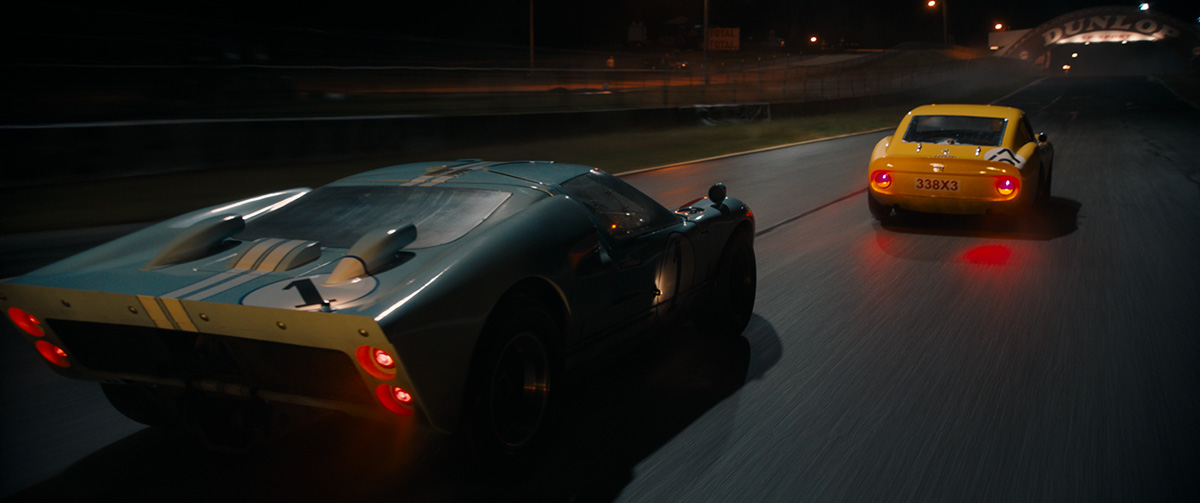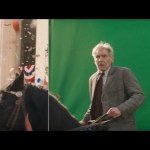How vFX and CG enhanced the action with stadiums, crowds, cars AND crashes.
I have to say that when I saw James Mangold’s Ford v Ferrari, I was so caught up in the story about car designer Carroll Shelby (Matt Damon) and driver Ken Miles (Christian Bale) and the orchestration of the race scenes that I barely thought about the visual effects work in the film at all.
But then when I talked to production visual effects supervisor Olivier Dumont (who also hails from Method Studios), it was quite stunning to hear just how significantly VFX helped bring pieces of the film together; there are 1048 visual effects shots in Ford v Ferrari.
Of course, this is ultimately not really that surprising, but it does show just how much of the work was ‘invisible’, from generating stadiums and crowds and to realizing CG cars and crashes. Here’s a look at 3 of the big kinds of effects challenges in the film – track, car and crash enhancement.
1. Track enhancement
There are three main races in Ford v Ferrari; Willow Springs, Daytona and Le Mans. Real locations were filmed for each, and many real sets crafted. VFX then stepped in to broaden the scope, remove modern artefacts – since the story takes place in the 60s – and add in stands, stadiums and crowds.
For example, the Daytona scenes were filmed in Fontana. “The main difference between the real Daytona and where we shot was that the real Daytona has a big lake in the middle of the track,” notes Dumont. “We tried to not shoot toward the middle to avoid any question about it.” For the race scenes here, Rising Sun Pictures (under VFX supervisor Malte Sarnes) added extra boxes above the stands, extended the pits and dealt with extraneous backgrounds. The studio also worked on scenes for the earlier Willow Springs race.


The main race was Le Mans, and for this sequence, production filmed in a number of locations in Southern California, including Agua Dulce Airpark in Santa Clarita, and also Georgia. The starting line was made up of four art department-built buildings that VFX extended to 13 buildings (bluescreens, including some huge 40-foot x 40-foot sections were used on location during the shoot). The visual effects work on the stands and pits, which included crowd additions, was handled by Method Studios, overseen by visual effects supervisor Dave Morley.


The studio relied on Golaem for crowds, basing their digital audience members on scans of extras on set. “We scanned a lot of people, about 300,” describes Dumont. “We worked with the wardrobe department and created different looks to populate the stands.” A motion capture session also informed the different CG spectator actions that would typically occur during the 24 hour race.
2. Racing enhancement
A number of methodologies were used to bring racing to the screen, with previs from Halon Entertainment helping to plan the various approaches. Some shots were of course filmed with real cars racing through the track. Other scenes made use of ‘pod cars’ in which professional drivers controlled the vehicle from a separate but attached section so that the actors could be filmed at the ‘wheel’.
A number of car interior scenes were captured on a stage with a ‘hovercraft’ air cushion apparatus and a car mock-up. Previously filmed background plates filmed with a camera array and a 360 degree camera were projected on LED screens (the footage was also used for digital environments).
Some practical racing scenes were sped up via visual effects. “We did this for two reasons,” explains Dumont. “Sometimes it was dangerous to get the cars going at full speed – depending on what you had as an environment, even if you go 100 miles an hour it can look only like you’re only going 50 mph. So we had to compensate for that to maintain the tension and the mood.”


The other reason, relates Dumont, was that there was a section of the race that happened in the rain. At one point, real rain machines were used, but it was also determined that the cars would not be able to drive as fast as they needed to in the rain, for safety reasons. “So in a lot of the shots they shut down the rain rigs in order to facilitate post-production rain,” says Dumont. “Also, it would have looked weird to have the rain sped up there.”
Then there were several CG cars and drivers provided by Method Studios. This included for the very start of Le Mans where extra cars and drivers were added, for scenes during the race, and for a crash shot (see below). Real cars were scanned to generate CG assets, with Method developing a driving rig that could be customized depending on the vehicle required.
3. Crash enhancement
Early in the race, Miles passes under the Dunlop bridge and witnesses another car hitting the wall and crashing. Here, the visual effects team from Method Studios essentially did a CG take-over for parts of that crash, preserving as much of the practical work conducted by stunts and special effects as they could (you can see the crash in the New York Times video, above).
“The director wanted to get the impact of a car as realistic as possible onto the ground,” recalls Dumont. “What we knew we could achieve and match was the ‘before and after’. So what we decided to do was have a canon, which was a truck that was driving on the side of the road with a launch system for a real car to be jettisoned into the air. They drove along at 20 miles per hour and then launched the car. What that gave us was a very hard impact on the ground.”
“Then,” adds Dumont, “we took that and blended it with the beginning of the shot – which we did in VFX – adding the car, blowing the tires, sliding and hitting the wall and then starting to go in the air. And this is then where we blended with the practical effects. We added to the impact with some more dirt and dust and parts exploding. They weren’t using, for the practical effects, a real car. It was just a shell, so we had to add a little bit more detail. But at least we had the physics correct, which really worked in our favor.”

















